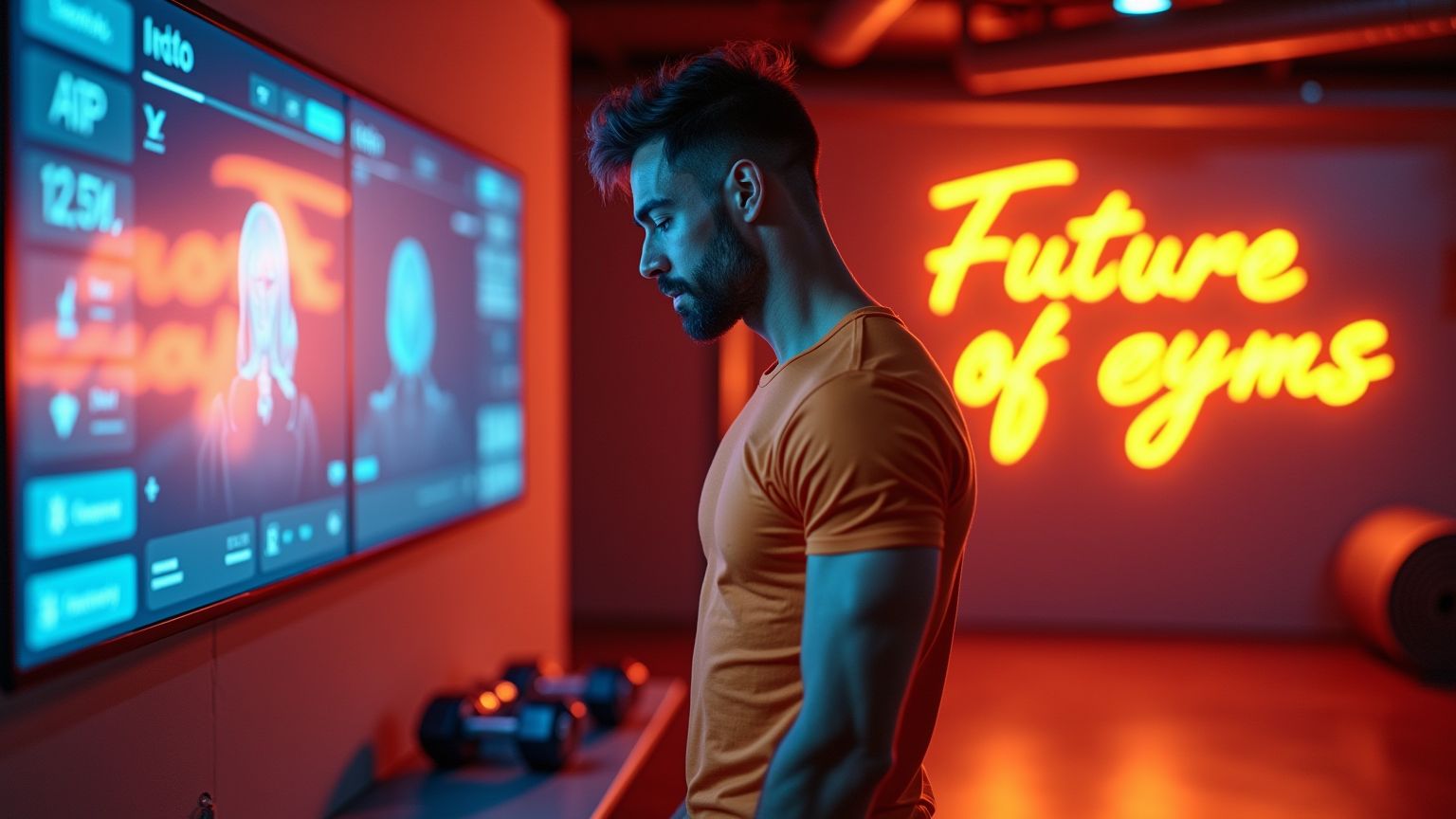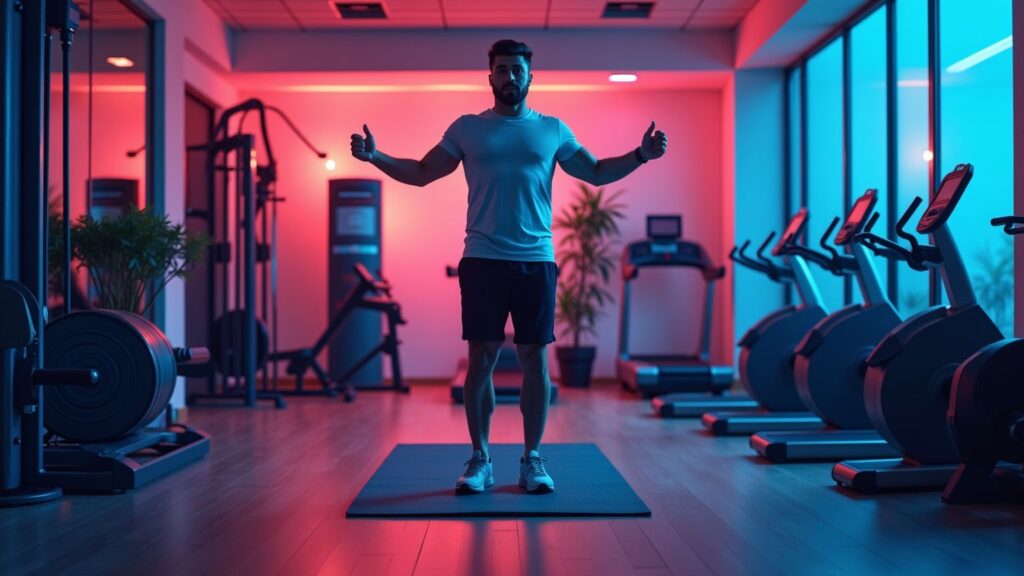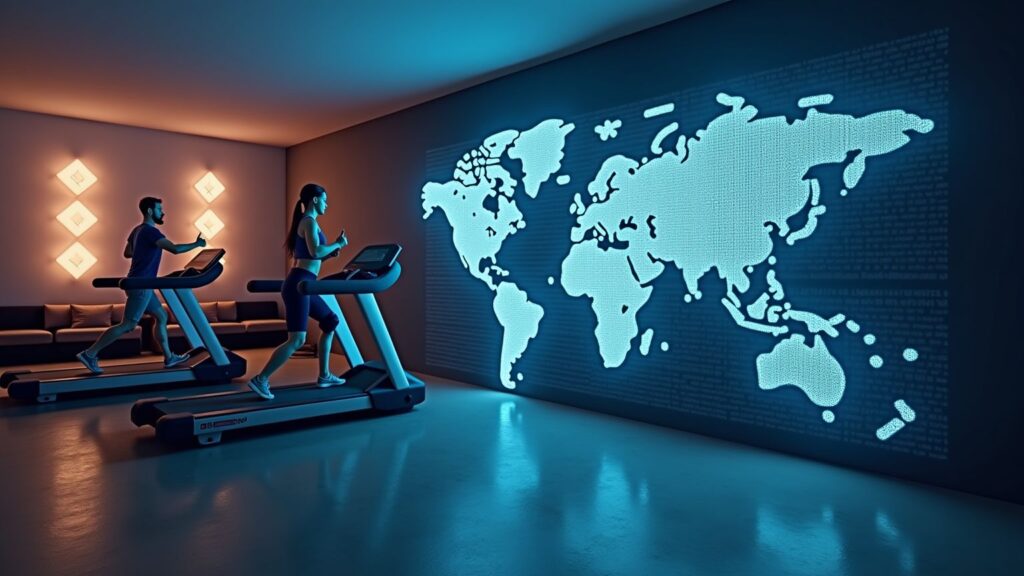The Future of AI in Smart Home Gyms: Envision the Trend
Imagine having a personal trainer available 24/7, one that knows your fitness goals, monitors your progress, and adjusts your workouts…

Imagine having a personal trainer available 24/7, one that knows your fitness goals, monitors your progress, and adjusts your workouts in real-time. Thanks to artificial intelligence (AI), this is no longer a futuristic dream but a present-day reality.
AI-driven smart home gyms are revolutionizing the way we exercise, making fitness more personalized, efficient, and accessible than ever before.
Over the past few years, AI has significantly impacted various industries, and fitness is no exception. From smart wearables that track your heart rate and movement to smart fitness mirror in home gym systems that offer real-time feedback, AI is reshaping the way we engage with fitness technology.
Whether you’re a beginner looking for guidance or an experienced athlete seeking advanced performance analysis, AI-powered solutions provide customized support tailored to your unique needs.
In this article, we’ll explore the Future of AI in Smart Home Gyms, from its early implementations to the rise of smart home gyms. We’ll also discuss the key technologies driving this transformation, the benefits of AI-integrated workout spaces, and the challenges that come with them.
Finally, we’ll take a look at what the future holds for AI in the fitness industry and how you can prepare for an AI-driven workout experience.
The Future of AI in Smart Home Gyms: The Evolution in Fitness Technology

Early AI Implementations in Fitness
AI has been making its way into the fitness industry for years, but early implementations were relatively simple compared to today’s advanced systems. The first wave of AI in fitness mostly focused on tracking and analyzing basic metrics like steps, heart rate, and calories burned.
Wearable fitness trackers, such as Fitbit and early Garmin devices, were among the first to introduce AI-driven features. These devices used algorithms to measure activity levels and provide users with general fitness insights.
While helpful, their recommendations were based on predefined models rather than real-time individualized data.
Besides wearables, AI-powered mobile apps started gaining popularity. Applications like MyFitnessPal used AI to analyze calorie intake and suggest dietary recommendations, while other apps provided workout recommendations based on user input.
However, these early solutions lacked the depth of personalization that modern AI fitness technology now offers.
Gyms also experimented with AI, incorporating smart treadmills and spin bikes that could adjust resistance based on workout intensity. While rudimentary by today’s standards, these innovations paved the way for the highly intelligent, adaptive fitness technologies we see today.
The Future of AI in Smart Home Gyms has come a long way, growing from simple tracking tools to fully personalized, real-time coaching solutions tailored to individual needs.
Growth of Smart Home Gyms
In recent years, smart home gyms have surged in popularity, redefining how people approach fitness. With advancements in artificial intelligence, these gyms have evolved from basic workout machines to fully interactive, data-driven personal trainers.
Whether you’re a seasoned athlete or someone just starting their fitness journey, AI-powered home gyms provide a tailored experience that was once only available in high-end training facilities.
One of the key drivers behind this growth is convenience. Traditional gym memberships often require commuting, waiting for equipment, and adhering to fixed schedules.
Smart home gyms eliminate these barriers, allowing you to work out anytime with on-demand AI coaching. Companies like Tonal, Mirror, and Tempo have brought cutting-edge AI and machine learning into the mix, offering personalized workout recommendations that adapt to your progress.
Beyond convenience, AI enhances workout efficiency. These systems track your form, count repetitions, and even suggest weight adjustments in real time. Some devices analyze your movements using motion sensors, ensuring proper technique and minimizing the risk of injury.
Plus, with interactive virtual classes and gamified challenges, staying motivated has never been easier.
As AI-driven technology continues to advance, smart home gyms are likely to become even more sophisticated, offering hyper-personalized training plans and deeper performance insights.
The fitness industry is shifting towards a future where your home gym isn’t just a place to exercise—it’s your personal fitness coach, motivator, and progress tracker all in one.
Key AI Technologies Transforming Home Gyms
AI is revolutionizing home workouts, making training smarter, more adaptive, and personalized. Whether you’re a beginner or a seasoned athlete, AI-powered smart gyms use cutting-edge technology to optimize your fitness journey like never before.
One of the most impactful AI innovations is **computer vision and motion tracking**. Smart fitness mirrors and connected equipment analyze your form in real time, providing instant feedback to correct posture and prevent injuries. This means you get the benefits of a personal trainer without leaving your home.
Another game-changer is **machine learning-driven workout recommendations**. AI adapts your exercise plan based on your strengths, weaknesses, and progress. Over time, it learns your preferences and adjusts intensity levels, ensuring you’re always challenged without overexertion.
Voice assistants and AI-powered coaching further streamline your workouts. Virtual trainers, integrated into devices like smart speakers or fitness mirrors, guide you through exercises, making routines feel interactive and engaging. AI can even customize sessions based on your energy levels and past performance.
Additionally, **wearable integration and biometric tracking** allow AI to collect and analyze data like heart rate, muscle fatigue, and sleep patterns. By leveraging this data, smart home gyms provide a holistic training experience that adapts to your body’s needs, fostering better results and injury prevention.
With these advancements, home gyms are no longer just about equipment—their intelligence makes them powerful fitness companions, offering an experience tailored just for you.
Benefits of AI-Integrated Smart Home Gyms
Personalized Workout Plans
Imagine having a personal trainer who knows exactly what your body needs at any given moment. That’s what AI-powered fitness technology brings to the table—custom workouts designed just for you. Unlike generic workout programs, AI-driven systems analyze your fitness level, goals, and performance data to craft a plan that evolves as you progress.
These smart systems use data from wearable devices, motion sensors, and even past workouts to adjust your routine dynamically. If you’re recovering from an injury, AI can modify exercises to reduce strain. If you’re struggling with consistency, it might suggest shorter, more engaging workouts to help you stay on track.
Another standout feature is the ability to factor in real-time data like heart rate, fatigue levels, and muscle recovery. Platforms like Tempo and Tonal use AI to recommend different exercises, adjust resistance, and even schedule rest days when needed. This ensures that your workouts remain both effective and safe.
Ultimately, AI-driven personalized workout plans remove the guesswork from fitness. Whether you’re a beginner looking for guidance or an experienced athlete aiming for peak performance, these smart systems get you closer to your fitness goals—faster and more efficiently than ever before.

Real-time Feedback and Training
One of the biggest advantages of AI-powered smart home gyms is their ability to provide real-time feedback on your workouts. Traditional home workouts often lack guidance, leaving you unsure whether you’re performing exercises correctly. With AI, that’s no longer an issue.
AI-integrated fitness technology uses motion sensors, cameras, and wearable devices to track your movements, posture, and form as you exercise. Advanced algorithms analyze your performance and instantly offer corrections, much like a personal trainer would.
If your squat depth is too shallow or your posture is slightly off, the AI will prompt you to adjust in real-time, helping you maximize effectiveness while reducing the risk of injury.
Beyond form correction, AI can also monitor your pace, repetitions, and endurance levels, adapting workouts based on your progress. Some systems use voice or visual cues to guide you, ensuring you stay engaged and motivated. Whether you’re lifting weights or doing yoga, the system can fine-tune your routine to match your goals.
This real-time responsiveness transforms the way you interact with home workouts. Instead of static, one-size-fits-all routines, AI-driven training evolves with you, ensuring that every session is effective, safe, and personalized. As technology continues to improve, we can expect even more intuitive, interactive fitness experiences.
Enhanced User Experience
AI-powered smart home gyms are revolutionizing the way you work out, making fitness more engaging, efficient, and enjoyable. By integrating advanced machine learning and computer vision technology, these systems adapt to your unique fitness level, learning your preferences to create a truly personalized experience.
One major enhancement is the ability to track your progress seamlessly. Smart fitness mirrors and AI-driven workout apps analyze your movements in real time, providing instant feedback on your form and technique. This helps you avoid injuries while ensuring that every rep counts. Additionally, voice-guided AI trainers can offer encouragement and modifications, just like a human coach would.
Gamification is another game-changer. Many AI-integrated platforms introduce elements like progress badges, virtual challenges, and leaderboards to keep you motivated. By adding friendly competition and achievements, your workouts become more like an interactive experience rather than a mundane routine.
Moreover, AI takes the guesswork out of fitness scheduling by recommending optimal workout times based on your energy levels and previous activity. Some systems even sync with wearable devices to adjust your workouts based on fatigue, heart rate, or recovery status.
In essence, AI doesn’t just make home workouts smarter—it makes them more enjoyable, engaging, and effective, keeping you on track toward your fitness goals without monotony or frustration.
Challenges and Concerns
Privacy and Data Security
With AI-powered home gyms collecting data on everything from your workout intensity to your heart rate, privacy and data security have become major concerns. While these technologies offer personalized fitness experiences, they also raise questions about how your sensitive information is stored, used, and shared.
The first concern is data collection. Smart fitness devices track not just physical movements but also biometric data, such as body composition and sleep patterns. This information can be incredibly valuable for personalized training but also poses a risk if not properly secured.
Then there’s the issue of data sharing. Some fitness platforms may share user data with third parties for marketing or research purposes. While this might help companies refine their products, it could also expose personal health details to advertisers or insurers without clear user consent.
To safeguard your information, look for home gym technologies that offer:
Ultimately, while AI-driven smart gyms bring convenience and innovation, you should always consider who has access to your data and how it’s being used. Taking extra steps to secure your privacy can help you enjoy the benefits without unnecessary risk.
Cost and Accessibility
AI-powered home gyms are revolutionizing fitness, but their price tags can be a significant barrier for many users. High-end smart fitness equipment, like AI-driven treadmills or interactive mirrors, can cost thousands of dollars.
On top of that, many systems require a monthly subscription for access to AI-generated workouts, personalized coaching, and real-time performance tracking. This ongoing expense can deter budget-conscious users from fully embracing AI-integrated fitness.
Accessibility is another major concern. While urban and suburban users may have easy access to smart gym technology, those in remote areas might struggle with connectivity issues. Many AI-powered fitness platforms rely on strong Wi-Fi for seamless performance, and without a stable internet connection, features like real-time coaching and cloud-based tracking may be disrupted.
Furthermore, AI fitness platforms often cater to a specific clientele—primarily those who are already somewhat tech-savvy and can afford both the equipment and subscriptions.
To make AI-driven home gyms more inclusive, companies must focus on affordability and accessibility. This could mean offering budget-friendly alternatives, flexible pricing plans, or offline functionality for users with limited connectivity. As AI grows, its benefits should be available to all fitness enthusiasts—not just those with deep pockets.
Technological Limitations
AI-powered smart gyms have revolutionized home workouts, but the technology still has its limitations. Understanding these challenges can help you set realistic expectations and make informed decisions when integrating AI into your fitness routine.
One major limitation is hardware constraints. While AI software continuously improves, its effectiveness depends on sensors, cameras, and wearable devices. If these tools lack accuracy, AI-driven workouts may provide unreliable feedback, leading to ineffective or even unsafe training recommendations.
Another challenge is algorithmic precision. AI relies on vast amounts of data to personalize workouts, but it can struggle to account for variables such as injuries, fatigue, or individual biomechanics. As a result, AI-driven programs may sometimes suggest exercises that aren’t entirely suited to your needs or fail to adjust for real-time physical conditions.
Then there’s the issue of internet dependency. Many smart gym systems rely on cloud-based AI processing, meaning slow or unstable internet connections can impact performance. A lag in AI response time can be frustrating, particularly when you rely on real-time guidance for exercises like weightlifting or yoga.
Despite these limitations, AI in fitness is continuously growing. As hardware improves, algorithms refine, and offline capabilities expand, these challenges will become less of a hurdle.
However, for now, it’s essential to complement AI-driven training with human expertise—whether through a personal trainer or your own knowledge—to ensure a balanced and safe fitness experience.
The Future Landscape of AI in Smart Gyms
Emerging Trends and Innovations
AI in fitness technology is evolving at a rapid pace, and smart home gyms are benefiting from continuous advancements. From intelligent virtual trainers to adaptive resistance systems, the future of AI-integrated workouts looks both exciting and transformative. If you’re wondering what’s next, here are some key trends to watch.
One of the biggest innovations is AI-powered motion tracking. Many smart workout systems are integrating real-time body scanning to correct your form and reduce injury risks. This means that instead of relying solely on pre-recorded workout videos, you’ll get instant feedback tailored to your movements.
Another emerging trend is the use of machine learning for progressively smarter workout recommendations. Many AI-driven fitness platforms already adjust routines based on past performance, but future systems will take this further. They’ll analyze everything from your heart rate to muscle fatigue, ensuring your workouts remain both effective and safe.
Additionally, wearable tech and connected home gym devices are becoming more integrated. Soon, your smartwatch, fitness tracker, and smart gym equipment will seamlessly communicate, creating a fully personalized fitness ecosystem.
As AI continues to develop, expect even more innovations that make home workouts more interactive, engaging, and efficient. The future of fitness isn’t just smart—it’s intelligent.
Long-term Implications for the Fitness Industry
AI is not just improving home gyms—it’s reshaping the entire fitness industry. As smart technology becomes more advanced, gyms, personal trainers, and fitness brands must adapt to stay relevant in a rapidly evolving landscape.
One major shift is the role of personal trainers. With AI-driven coaching systems providing real-time feedback and personalized workout plans, some may wonder if human trainers will become obsolete.
However, instead of replacing trainers, AI is likely to enhance their roles, allowing them to focus on motivation, injury prevention, and tailor-made human interaction that technology can’t replicate.
Additionally, AI is making fitness more accessible. Virtual trainers and AI-powered apps allow people to receive expert guidance without the need for expensive gym memberships. This democratization of fitness means more people can achieve their health goals regardless of location or budget.
However, the widespread adoption of AI-driven fitness also presents challenges. Traditional gyms may need to innovate by integrating smart technology into their offerings or risk losing customers to at-home solutions.
Moreover, fitness brands must ensure that technology enhances rather than overwhelms the user experience, maintaining a personal touch in an increasingly digital world.
In the long run, AI will likely create a hybrid fitness experience—blending technology with human expertise to build a more personalized, efficient, and engaging approach to health and wellness.
Preparing for an AI-driven Fitness World
As AI continues to revolutionize the fitness industry, adapting to this new landscape will be key to making the most of its benefits. Whether you’re an individual looking to optimize your workouts or a gym owner hoping to integrate AI-driven technology, understanding how to prepare for an AI-powered future is essential.
One of the most important steps is staying informed about the latest advancements in fitness technology. AI-powered fitness tools grow rapidly, and keeping up with emerging trends—such as virtual trainers, motion-sensing workouts, and biometric tracking—ensures you’re making the most of available innovations.
For gym-goers and fitness enthusiasts, embracing AI-driven platforms can mean a more tailored and efficient workout experience. Start by exploring apps and devices that provide personalized coaching, real-time feedback, and progress tracking to optimize your fitness journey.
For fitness professionals and industry leaders, preparing for this shift involves integrating AI into existing business models. This could mean offering smart home gym solutions, providing AI-powered personal training, or leveraging data analytics to better understand customer needs and improve services.
As AI becomes more prevalent in fitness, the key is adaptability. By staying open to technological advancements and incorporating AI into workout routines and business strategies, both individuals and organizations can thrive in this rapidly growing fitness world.
Conclusion
The rapid evolution of AI in smart home gyms is reshaping the way you approach fitness, offering personalized workouts, real-time feedback, and a highly interactive user experience.
With intelligent systems guiding your training, you no longer have to rely on generic advice—your workouts can now be tailored specifically to your needs, goals, and progress.
However, while AI-powered fitness technology brings many advantages, challenges such as privacy concerns, high costs, and potential technical limitations still need to be addressed.
As innovation continues, expect to see more accessible and affordable AI-driven solutions, like smart fintess mirrors, making smart home gyms a standard rather than a luxury.
Looking ahead, AI will probably play an even more significant role in shaping the future of fitness. From immersive virtual coaching to predictive health analytics, the possibilities are vast. If you’re considering integrating AI into your fitness routine, now is the perfect time to explore your options and stay ahead of the curve.
Smart home gyms powered by AI aren’t just a trend—they’re the future of personalized and effective fitness. The key is to embrace these advancements while staying informed about their benefits and challenges. Are you ready to let AI reshape your fitness journey?
